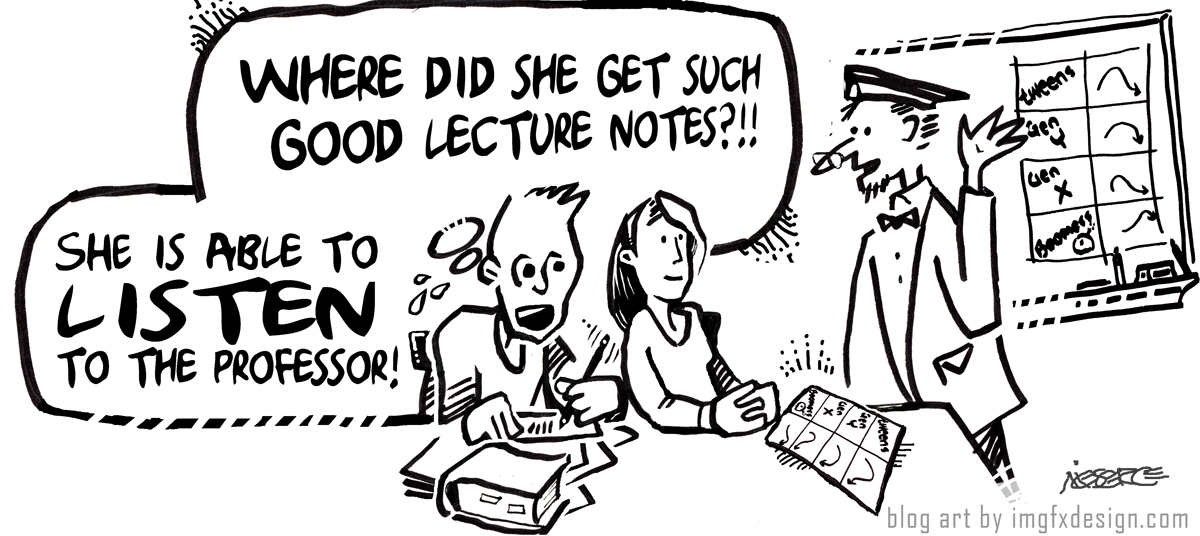
Should college be about who can take the best notes while a professor lectures? (No) Does industry place a high importance on a work professional’s ability to take copious notes while someone is speaking for a straight hour? (No) Then the logical conclusion is that undergraduate business schools should advocate to their faculty to provide detailed lecture slide handouts at the outset of class which results in major benefits:
- Course coverage is enhanced as note taking slows things down.
- Students are able to truly listen and absorb concepts. This is especially vital when course focus is on application.
- Students with learning challenges are not penalized due to possible note taking deficiencies.
Course Coverage Is Enhanced As Note Taking Sloooooows Things Down
One of my Core Values is “Treat class time as precious. There are only 38 hours of class time in the semester; less than one standard work week.” The dilemma of expecting students to take copious class notes is the following; at what pace does the professor lecture at ? Should one lecture at a pace that allows the slowest note taker to accurately obtain information; or at some faster pace where one begins to lose a certain percentage of the class ? I estimate that I am able to cover at least 50% more material by handing out detailed lecture slides at the outset of class. The course experience is obviously heightened by covering more material per class, and aggregately throughout the semester. This benefit is covered extensively in the article about the merits of Breadth versus Depth.
Students Are Able To Truly Listen And Absorb Concepts
How can students intensely take notes and really listen to the meaning of what a professor is saying ? They can’t; their total focus is on getting the words down; the understanding is secondary. If the course is primarily content based (what I refer to as memorization/regurgitation) then this is not as much of an issue. However if the course has an application focus then the students are missing a lot of the critical thinking and real world relevance.
Students With Learning Challenges Are Not Penalized Due To Possible Note Taking Deficiencies
The playing field of college courses should not depend on a student’s note taking speed and accuracy. This is especially true for a significant amount of students with identified learning challenges. Universities today are making concerted efforts to assure that they are not at a disadvantage. Some very exceptional students have a slower speed and/or accuracy in note taking and they should not be made to feel incapable. Very few business careers focus on speed; they focus on non-time sensitive problem solving that is creative, resourceful and strategic.
Professor Requesting Students To Conceal Their Notes Temporarily
There are times when a professor wants the students to benefit from learning a concept from a progression of questions during open class discussion. To accomplish this, students can not have the answers to your series of questions as it takes away from the learning experience. There are key concepts where struggling to arrive at the answers is a lot more powerful than furnishing the answers directly on the lecture handouts. So how can you accomplish this common learning technique if you hand out detailed lecture slides at the outset of class ?
When I initially began teaching I would take the handouts and “white out” certain portions. Then students would have to actively contribute to arrive at the appropriate answers that I was leading them towards. This is problematic as the entire class must wait for the professor to confirm that the student’s response was the correct answer before beginning to write the response down. “What did Joe Student say? Could you repeat that Professor Heller?” In addition to having to repeat the correct student response, it is rather frustrating waiting for the slower students to finish writing down notes. “Is everyone caught up with their notes?” This is not a productive use of class time.
The solution to this dilemma was handing out the complete set of notes at the outset of class with one provision. Periodically during the lecture I ask the students to place their notes on the floor or turn them upside down. This way one can accomplish the learning objective of progressively working towards these key concepts. I explain the only alternative is whiting out certain portions of the lecture slides which will require them to take accurate notes. This technique has worked out quite well as the students have been very compliant. It is very easy to keep the students attention away from their notes by scanning your classroom for good eye contact as there is no reason to be looking down at their papers.
Paper Handout Usage: Being Conservative or Extravagant
I have taught under a wide spectrum of departmental copying policies. One policy limited copying only to the syllabus and tests; other policies have been totally open to the needs of professor. I feel guilty from both an ecological and cost standpoint in not conserving paper. With Power Point you can print out slides on the two per page setting, and then realign them comfortably onto a four per page format, see FREE Attachment illustration of my lecture slides. With double sided copying this allows one to get eight slides per page. I develop my own lecture slides and most often I am able to use only one page of lecture slides per class. Lecture slides from the publishers usually require more than twice the number of slides as the information density is considerably less than those you may develop.
The only dilemma I run into is students complaining that there isn’t enough room to add notes onto the slides in the four per page format. Depending on the respective department’s copying policy, I may drop down to three per page to provide more space for student notes.
Detailed Lecture Notes Involve Custom Slides Requiring Professors to Dedicate More Time
Many professors rely on “can” slides that are from the publisher of the textbook. I have not found these publisher slides typically detailed enough. Many times they are summary-level, bullet-point slides from which to talk from, not providing students enough detail to stand alone without additional note taking required. To create lecture slides that allow the professor to concentrate on application and cover more content; professors need to spend considerable time modifying and re-writing slides provided by publisher.
Unfortunately most undergraduate faculty are unable to devote this amount of time involved in developing quality and comprehensive slides. Research, publishing, presentations, committee work are the priorities of the vast majority of today’s undergraduate faculty and graduate students. Instructing students comes after the above priorities, which drive tenure, compensation and day-to-day departmental recognition.
Propelling Course Effectiveness Through Providing Detailed Lecture Slides
Handing out lecture slides at the outset of class has strong merits especially when combined with getting compliance from students to conceal their handouts at select times. This approach allows the students to become fully engaged in the concepts and application of lecture without the anxiety and intensity of furiously taking notes. On a broader perspective this approach creates enhanced lecture time efficiency that allows the professor to provide substantially more topics and total content over the semester.
